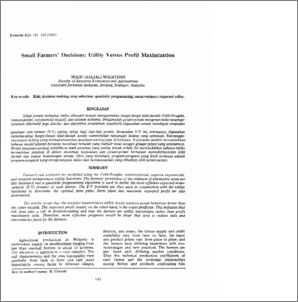Citation
Mohayidin, Mohd. Ghazali
(1982)
Small Farmers' Decisions: Utility Versus Profit Maximization.
Pertanika, 5 (2).
pp. 141-153.
Abstract
Farmer's risk attitudes are modelled using the Cobb-Douglas, transcendental, negative exponential,
and conjoint measurement utility functions. The farmers' perception of the riskiness ofaltemative crops are
also measured and a quadratic programming algorithm is used to derive the most efficient expected meanvariance
(E- V) frontier of each farmer. The E- V frontiers are then used in conjunction with the utility
junctions to determine the optimal farm plans. Farm plans that maximise expected profit are also
determined.
The results reveal that the conjoint measurement utility model predicts actual behaviour better than
the other models. The expected profit model, on the other hand, is the worst predictor. This indicates that
risk does playa role in decision-making and that the farmers are utility maximizers rather than profit
maximizers only. Therefore, more effective programs would be those that tend to reduce risks and
uncertainties faced by the farmers.
Download File
![[img]](http://psasir.upm.edu.my/style/images/fileicons/application_pdf.png)  Preview |
|
PDF
Small_Farmers'_Decisions_Utility_Versus_Profit_Maximization.pdf
Download (5MB)
|
|
Additional Metadata
| Item Type: |
Article
|
| Keywords: |
Risk; decision making; crop selection; quadratic programming; mean-variance; expected uility. |
| Depositing User: |
Nur Izyan Mohd Zaki
|
| Date Deposited: |
11 Nov 2009 04:50 |
| Last Modified: |
27 May 2013 06:59 |
| URI: |
http://psasir.upm.edu.my/id/eprint/2187 |
| Statistic Details: |
View Download Statistic |
Actions (login required)
 |
View Item |

